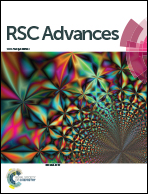Synthesis of α-d-Glcp-(1→3)-α-d-Galf-(1→2)-α-l-Rhap constituent of the CPS of Streptococcus pneumoniae 22F. Effect of 3-O-substitution in 1,2-cis α-d-galactofuranosylation†
Abstract
The synthesis of the trisaccharide α-D-Glcp-(1→3)-α-D-Galf-(1→2)-L-Rhap (3) constituent of Streptococcus pneumonia 22F was achieved with complete diastereoselectivity. This is the first example of a synthesis of an internal α-D-Galf containing oligosaccharide of a pathogen microorganism. Allyl α-D-galactofuranoside, used as novel precursor of the internal Galf, allowed the introduction of an orthogonal group at O-3. The trichloroacetimidate method was used for the construction of 1,2-cis-α-D-galactofuranosyl linkage. The influence of the 3-O-substituent (PMB, Bz, PFBz, PMBz, TIPS) was evaluated in benzylated galactofuranosyl trichloroacetimidate donors in terms of yield and selectivity of α-D-Galf-(1→2)-α-L-Rhap product as well as donor rearrangement by-product. Complete stereoselectivity was observed with all protecting groups used in the Galf donor, but the 3-O-benzoyl substitution gave the best yield. Protective groups were also evaluated in the rhamnoside acceptor, benzyl substitution was a requirement for complete stereoselectivity.


 Please wait while we load your content...
Please wait while we load your content...